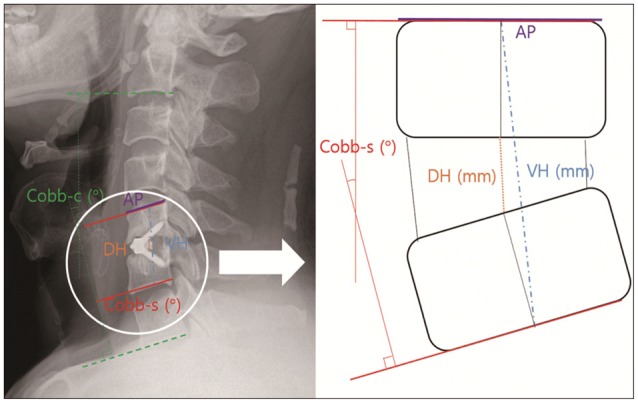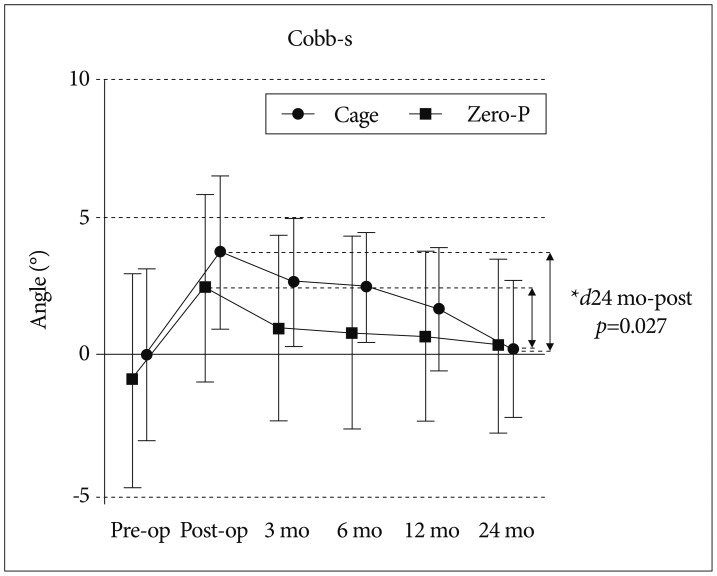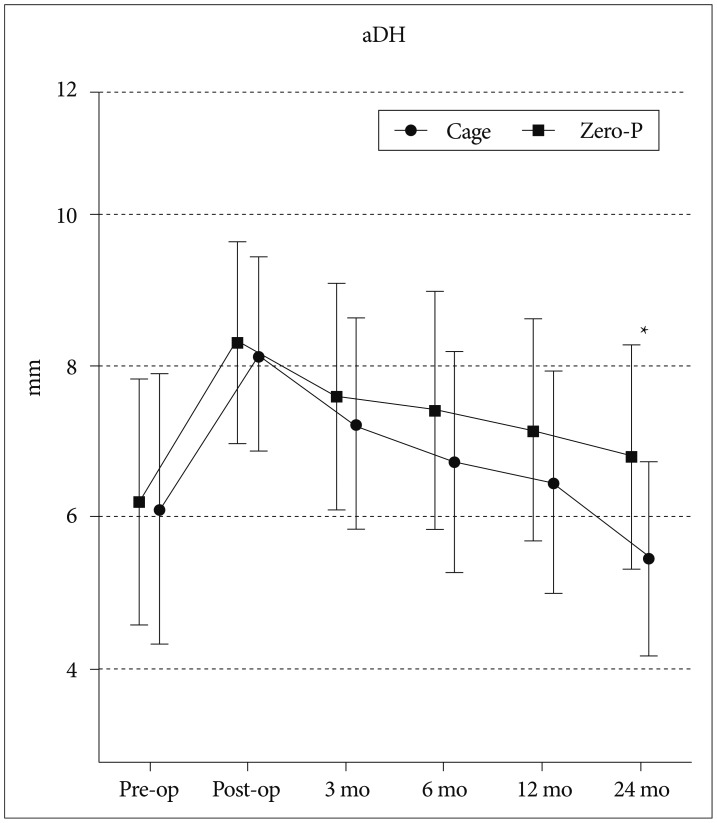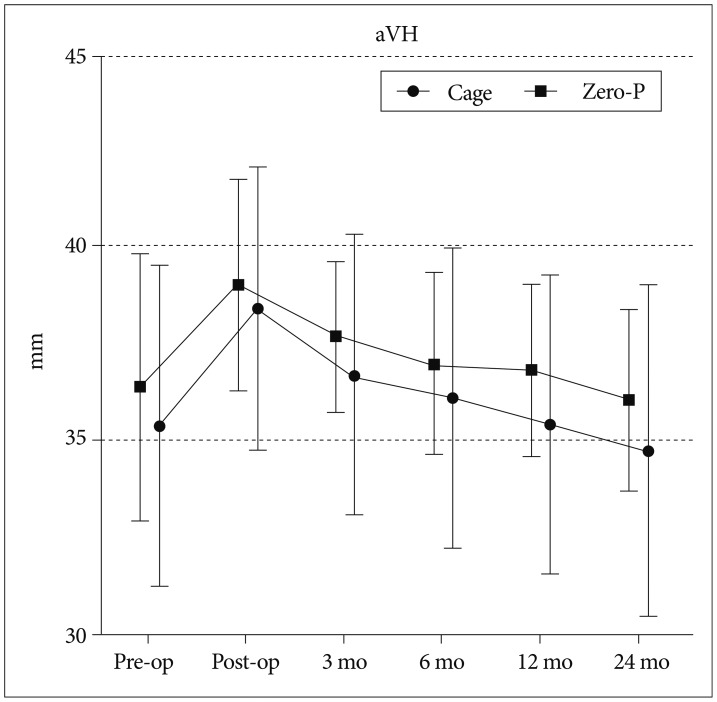J Korean Neurosurg Soc.
2015 Aug;58(2):119-124. 10.3340/jkns.2015.58.2.119.
Cervical Stand-Alone Polyetheretherketone Cage versus Zero-Profile Anchored Spacer in Single-Level Anterior Cervical Discectomy and Fusion : Minimum 2-Year Assessment of Radiographic and Clinical Outcome
- Affiliations
-
- 1Department of Neurosurgery, Korea University Anam Hospital, College of Medicine, Korea University, Seoul, Korea. jblee42@gmail.com
- KMID: 2191319
- DOI: http://doi.org/10.3340/jkns.2015.58.2.119
Abstract
OBJECTIVE
We compared the clinical and radiographic outcomes of stand-alone polyetheretherketone (PEEK) cage and Zero-Profile anchored spacer (Zero-P) for single level anterior cervical discectomy and fusion (ACDF).
METHODS
We retrospectively reviewed 121 patients who underwent single level ACDF within 2 years (Jan 2011-Jan 2013) in a single institute. Total 50 patients were included for the analysis who were evaluated more than 2-year follow-up. Twenty-nine patients were allocated to the cage group (m : f=19 : 10) and 21 for Zero-P group (m : f=12 : 9). Clinical (neck disability index, visual analogue scale arm and neck) and radiographic (Cobb angle-segmental and global cervical, disc height, vertebral height) assessments were followed at pre-operative, immediate post-operative, post-3, 6, 12, and 24 month periods.
RESULTS
Demographic features and the clinical outcome showed no difference between two groups. The change between final follow-up (24 months) and immediate post-op of Cobb-segmental angle (p=0.027), disc height (p=0.002), vertebral body height (p=0.033) showed statistically better outcome for the Zero-P group than the cage group, respectively.
CONCLUSION
The Zero-Profile anchored spacer has some advantage after cage for maintaining segmental lordosis and lowering subsidence rate after single level anterior cervical discectomy and fusion.
Keyword
MeSH Terms
Figure
Cited by 1 articles
-
Can the Zero-Profile Implant Be Used for Anterior Cervical Discectomy and Fusion in Traumatic Subaxial Disc Injury? A Preliminary, Retrospective Study
Tae Hun Kim, Dae Hyun Kim, Ki Hong Kim, Young Seok Kwak, Sang Gyu Kwak, Man Kyu Choi
J Korean Neurosurg Soc. 2018;61(5):574-581. doi: 10.3340/jkns.2018.0090.
Reference
-
1. Barbagallo GM, Romano D, Certo F, Milone P, Albanese V. Zero-P : a new zero-profile cage-plate device for single and multilevel ACDF. A single institution series with four years maximum follow-up and review of the literature on zero-profile devices. Eur Spine J. 2013; 22(Suppl 6):S868–S878. PMID: 24061968.2. Bartels RH, Donk RD, Feuth T. Subsidence of stand-alone cervical carbon fiber cages. Neurosurgery. 2006; 58:502–508. discussion 502-508PMID: 16528190.
Article3. Cho DY, Lee WY, Sheu PC. Treatment of multilevel cervical fusion with cages. Surg Neurol. 2004; 62:378–385. discussion 385-386PMID: 15518835.
Article4. Dufour T, Huppert J, Louis C, Beaurain J, Stecken J, Aubourg L, et al. Radiological analysis of 37 segments in cervical spine implanted with a peek stand-alone device, with at least one year follow-up. Br J Neurosurg. 2010; 24:633–640. PMID: 20632875.
Article5. Fraser JF, Härtl R. Anterior approaches to fusion of the cervical spine : a metaanalysis of fusion rates. J Neurosurg Spine. 2007; 6:298–303. PMID: 17436916.
Article6. Fujibayashi S, Neo M, Nakamura T. Stand-alone interbody cage versus anterior cervical plate for treatment of cervical disc herniation : sequential changes in cage subsidence. J Clin Neurosci. 2008; 15:1017–1022. PMID: 18653347.
Article7. Healy AT, Sundar SJ, Cardenas RJ, Mageswaran P, Benzel EC, Mroz TE, et al. Zero-profile hybrid fusion construct versus 2-level plate fixation to treat adjacent-level disease in the cervical spine. J Neurosurg Spine. 2014; 21:753–760. PMID: 25170655.
Article8. Hofstetter CP, Kesavabhotla K, Boockvar JA. Zero-profile Anchored Spacer Reduces Rate of Dysphagia Compared With ACDF With Anterior Plating. J Spinal Disord Tech. 2015; 28:E284–E290. PMID: 23429316.
Article9. Joo YH, Lee JW, Kwon KY, Rhee JJ, Lee HK. Comparison of fusion with cage alone and plate instrumentation in two-level cervical degenerative disease. J Korean Neurosurg Soc. 2010; 48:342–346. PMID: 21113362.
Article10. Katsuura A, Hukuda S, Saruhashi Y, Mori K. Kyphotic malalignment after anterior cervical fusion is one of the factors promoting the degenerative process in adjacent intervertebral levels. Eur Spine J. 2001; 10:320–324. PMID: 11563618.
Article11. Kim CH, Chung CK, Hahn S. Autologous iliac bone graft with anterior plating is advantageous over the stand-alone cage for segmental lordosis in single-level cervical disc disease. Neurosurgery. 2013; 72:257–265. discussion 266PMID: 23149973.
Article12. Korinth MC. Treatment of cervical degenerative disc disease - current status and trends. Zentralbl Neurochir. 2008; 69:113–124. PMID: 18666050.
Article13. Matz PG, Ryken TC, Groff MW, Vresilovic EJ, Anderson PA, Heary RF, et al. Techniques for anterior cervical decompression for radiculopathy. J Neurosurg Spine. 2009; 11:183–197. PMID: 19769498.
Article14. Miao J, Shen Y, Kuang Y, Yang L, Wang X, Chen Y, et al. Early follow-up outcomes of a new zero-profile implant used in anterior cervical discectomy and fusion. J Spinal Disord Tech. 2013; 26:E193–E197. PMID: 23168389.
Article15. Mummaneni PV, Kaiser MG, Matz PG, Anderson PA, Groff MW, Heary RF, et al. Cervical surgical techniques for the treatment of cervical spondylotic myelopathy. J Neurosurg Spine. 2009; 11:130–141. PMID: 19769492.
Article16. Njoku I Jr, Alimi M, Leng LZ, Shin BJ, James AR, Bhangoo S, et al. Anterior cervical discectomy and fusion with a zero-profile integrated plate and spacer device : a clinical and radiological study : clinical article. J Neurosurg Spine. 2014; 21:529–537. PMID: 25105338.
Article17. Qi M, Chen H, Liu Y, Zhang Y, Liang L, Yuan W. The use of a zero-profile device compared with an anterior plate and cage in the treatment of patients with symptomatic cervical spondylosis : a preliminary clinical investigation. Bone Joint J. 2013; 95-B:543–547. PMID: 23539708.18. Salvati M, Cervoni L, Artico M, Raco A, Ciappetta P, Delfini R. Primary spinal epidural non-Hodgkin's lymphomas : a clinical study. Surg Neurol. 1996; 46:339–343. discussion 343-344PMID: 8876714.19. Schmieder K, Wolzik-Grossmann M, Pechlivanis I, Engelhardt M, Scholz M, Harders A. Subsidence of the wing titanium cage after anterior cervical interbody fusion : 2-year follow-up study. J Neurosurg Spine. 2006; 4:447–453. PMID: 16776355.
Article20. Scholz M, Schnake KJ, Pingel A, Hoffmann R, Kandziora F. A new zero-profile implant for stand-alone anterior cervical interbody fusion. Clin Orthop Relat Res. 2011; 469:666–673. PMID: 20882376.
Article21. Shin JS, Oh SH, Cho PG. Surgical outcome of a zero-profile device comparing with stand-alone cage and anterior cervical plate with iliac bone graft in the anterior cervical discectomy and fusion. Korean J Spine. 2014; 11:169–177. PMID: 25346764.
Article22. Son DK, Son DW, Kim HS, Sung SK, Lee SW, Song GS. Comparative study of clinical and radiological outcomes of a zero-profile device concerning reduced postoperative dysphagia after single level anterior cervical discectomy and fusion. J Korean Neurosurg Soc. 2014; 56:103–107. PMID: 25328646.
Article23. Tampier C, Drake JD, Callaghan JP, McGill SM. Progressive disc herniation : an investigation of the mechanism using radiologic, histochemical, and microscopic dissection techniques on a porcine model. Spine (Phila Pa 1976). 2007; 32:2869–2874. PMID: 18246010.24. van Jonbergen HP, Spruit M, Anderson PG, Pavlov PW. Anterior cervical interbody fusion with a titanium box cage : early radiological assessment of fusion and subsidence. Spine J. 2005; 5:645–649. discussion 649PMID: 16291105.
Article25. Wang Z, Jiang W, Li X, Wang H, Shi J, Chen J, et al. The application of zero-profile anchored spacer in anterior cervical discectomy and fusion. Eur Spine J. 2015; 24:148–154. PMID: 25337859.
Article
- Full Text Links
- Actions
-
Cited
- CITED
-
- Close
- Share
- Similar articles
-
- Comparison between Two Different Cervical Interbody Fusion Cages in One Level Stand-alone ACDF: Carbon Fiber Composite Frame Cage Versus Polyetheretherketone Cage
- Anterior Cervical Discectomy and Fusion Using a Stand-Alone Polyetheretherketone Cage Packed with Local Autobone : Assessment of Bone Fusion and Subsidence
- The Advantages of Rectangular Titanium Cage(RABEA) Fusion after Anterior Cervical Discectomy: Comparative Study of Fibula Allograft
- Stand-Alone Cervical Cages in 2-Level Anterior Interbody Fusion in Cervical Spondylotic Myelopathy: Results from a Minimum 2-Year Follow-up
- Surgical Outcome of a Zero-profile Device Comparing with Stand-alone Cage and Anterior Cervical Plate with Iliac Bone Graft in the Anterior Cervical Discectomy and Fusion





